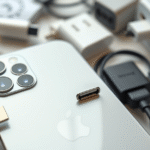The iPhone Price landscape is poised for change as Apple gears up for the release of the highly anticipated iPhone 17.
With this new model, the tech giant is not only planning to raise prices but also introduce cutting-edge ‘Apple Intelligence’ features that promise to elevate user experience.
This article will delve into what consumers can expect, including a substantial RAM upgrade to 12GB for select versions and how external factors like tariffs may impact Apple’s pricing strategy.
Join us as we explore the speculated starting price and the adjustments Apple might make in response to a dynamic market.
Key Factors Driving the iPhone 17 Price Increase
Apple’s decision to raise the iPhone 17’s pricing stems from a combination of strategic innovation and economic pressure.
With the introduction of enhanced “Apple Intelligence” features, including a considerable RAM increase to 12GB in certain models, Apple positions the device not just as a smartphone, but as a powerful AI-enabled tool.
This move supports Apple’s value proposition of offering cutting-edge technology, reinforcing its stance as a premium brand.
Moreover, by setting higher price points, Apple also manages to differentiate its top-tier products from mid-tier alternatives, optimizing its product segmentation strategy.
According to this business report, the company suggests that new features justify the potential hikes, leveraging performance improvements as a selling point
Economically, external market forces such as U.S. tariffs impact the pricing dynamics.
Analysts predict up to a 43% increase due to geopolitical trade conditions, as noted in this analysis.
Tariffs on foreign-made components and inflationary supply chain expenses continue to pressure Apple’s margins.
By subtly adjusting pricing, the company retains profitability without sacrificing build quality.
At the same time, emphasizing perceived customer value allows Apple to maintain demand among loyal buyers despite swelling costs
- Greater AI capabilities and RAM upgrades improve product value
- Tariff effects and supply chain inflation challenge cost structures
- Premium pricing supports Apple’s long-term brand strategy
‘Apple Intelligence’ Capabilities That Add Value
The iPhone 17 introduces advanced Apple Intelligence capabilities that seamlessly integrate with iOS 18, enhancing functionality across productivity, communication, and creativity.
These on-device features combine generative AI with deep personal context to automate and simplify daily tasks.
Users can now generate email summaries, rewrite messages with custom tones, create Genmoji based on their own expressions, and enjoy image creation through Image Playground.
These tools work hand-in-hand with a new 12GB RAM configuration, ensuring fluid performance that supports real-time tasks without compromising speed or privacy.
According to an official source from Apple Intelligence, all processing happens locally or through secure cloud servers, protecting users’ data at every step.
Such innovation does more than refine user experience—it redefines what’s expected from a smartphone, fully justifying potential price increases as users receive more value, personalization, and control than ever before.
Performance Gains From the 12GB RAM Upgrade
The iPhone 17’s advancement to 12GB of LPDDR5 RAM marks a strategic improvement that significantly boosts device responsiveness and multitasking.
Compared to the 8GB modules in previous models, LPDDR5 memory not only offers faster bandwidth but also more efficient app switching and system fluidity.
This translates directly into a noticeable speed boost when juggling multiple high-demand apps or re-opening recently used processes.
As reported by analysts, these enhancements are particularly impactful when running enhanced Apple Intelligence features, which leverage RAM-heavy inference models and on-device learning protocols.
The additional memory headroom supports simultaneous background tasks, preserving performance consistency and app state retention across sessions.
Moreover, embedded AI tools in the iPhone 17, including predictive typing and real-time translation, rely on high memory bandwidth to maintain on-device privacy without compromising throughput.
According to Tom’s Guide analysis, LPDDR5 is also more power-efficient, helping extend battery life despite the rise in processing demands.
This synergy between RAM capacity and performance lays the groundwork for a seamless next-gen mobile experience while justifying the pricing premium Apple may apply to the iPhone 17 series.
Projected Price Point and Anticipated Market Response
Rumors surrounding the iPhone 17 suggest a starting price range of $999–$1,099, with some speculation hinting at even higher pricing depending on the storage and model variant.
This projected increase coincides with major hardware enhancements such as the inclusion of 12GB RAM and new Apple Intelligence capabilities.
According to PhoneArena’s preview of Apple’s 2025 devices, potential tariffs and advanced AI features are major contributors to the upward pricing trend.
- Consumers are expected to react strongly, especially early adopter demand likely driving initial sales despite the premium price tag
- Competitors in the Android segment may respond by adding their own AI enhancements while keeping price points more flexible to capture market share
- Retailers might prepare for recalibrated inventory strategies and increased interest in installment plans or trade-in promotions to offset pricing concerns
A recent analysis by Bloomberg’s Mark Gurman noted Apple’s pricing strategy is aimed at justifying the tech leap while sustaining premium brand perception
In conclusion, the iPhone 17’s expected price hike reflects Apple’s commitment to innovation while navigating market challenges.
As new features and upgrades are introduced, consumers should stay informed about how these changes might affect their purchasing decisions.




